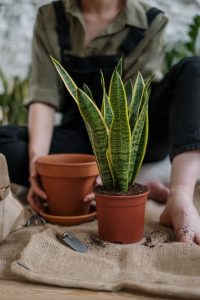How to Repot a Houseplant: Get It Right the First Time
Repotting a houseplant can be challenging and you might end up doing more harm than good to your plant. However, with a few helpful tips, you can successfully repot your plant and watch it thrive. Repotting a plant involves using fresh potting soil to revamp your plant’s growth or planting the houseplant in a larger container to create more room for growth. Either way, repotting your plant correctly is the key to a beautiful and healthy plant. In our article, you will learn how to repot a houseplant correctly. Keep reading to discover more.
How to repot a houseplant

Your houseplant has probably outgrown its container and depleted the nutrients in its soil. In this case, your plant will need a larger pot and fresh soil with ample nutrients to remain healthy.
What you need to repot your houseplant
There are several materials you will require to successfully re-pot your plant. These materials include:
- Your plant
- A clean planter
- Fresh potting soil with ample nutrients
- If your planter lacks drainage holes, you will need Lava rocks
- Gloves to keep your hands clean and protect your skin from poisonous plants
- Newspaper or potting tarp to ease cleaning
- A watering can or spray bottle
How do you repot a houseplant?
After gathering your potting materials, you can now easily repot your houseplant. Here is how to repot a houseplant into a bigger pot.
1. Water your plant the day before repotting
Before repotting your plant, water it a day before to make it easier to separate from the soil. Handling too dry or damp soil can bruise your plant’s roots.
2. Gently remove your plant from its pot
The best way to repot a houseplant is by being extra gentle. Carefully remove your plant from the pot by turning it sideways. Hold the plant by its stems and tap the bottom of the pot until the plant slides out. You can also gently squeeze the sides of the pot to help ease the plant out.
3. Loosen the roots of your plant
Gently loosen the roots of your plant by massaging the root ball. Examine your roots and prune dead and damaged ones. Try to free up the roots as much as possible to ensure they absorb adequate moisture and nutrients from the soil.
4. Add fresh fast-draining soil to the new planter or pot
Choose a planter or pot that is slightly larger than your current one. The ideal container should be 1 or 2 inches larger than your current pot. If you re-pot your plant into a big pot, the plant’s roots might rot eventually killing it. This is because your plant is incapable of absorbing the excess moisture in the soil leading to waterlogging.
Add fresh fast-draining soil to the bottom third of your new planter. If your container does not have drainage holes, place lava rocks at the bottom before adding fresh potting soil.
5. Plant your houseplant in the new pot
Plant your houseplant in the fresh potting mix and add more soil to secure the plant in place. Just add enough potting soil to provide your plant’s roots with plenty of breathing space.
Leave some space below the top of the plant. Too much soil will prevent proper watering. When watering your plant, water will spill over the sides of your container instead of soaking into the soil.
6. Water your plant uniformly
Once your plant is secure, water the soil uniformly to keep it lightly moist. Be careful not to overwater your plant. Ensure excess water drains completely from the soil to prevent waterlogging. You are now free to enjoy your newly potted plant.
How to repot a palm houseplant
Repotting a palm houseplant is quite easy. You should repot your palm houseplant every 1 or 2 years when it becomes top-heavy. The best time to repot your Palm plant is during spring or early summer. Below is how to repot a houseplant- YouTube.
- Select a slightly larger pot preferably 2 to 3 inches larger
- Mix fresh potting soil with slow-release fertilizer
- Add fresh potting soil to the bottom third of your new pot
- Gently remove your Palm plant from the old pot by gently tugging the bottom of the trunk. Tap the bottom and side of the pot to ease the plant out
- Loosen the roots carefully to avoid damaging the root ball
- Place your plant in the new container and add soil to hold it in place
- Even out the soil and uniformly water your plant while allowing excess water to drain out
When to repot a houseplant
When is a good time to repot houseplants? This might be the question running through your mind while trying to figure out when to repot your rubber plant or Pothos plant. How often you should re-pot your houseplant depends on its variety.
Fast-growing houseplants require to be repotted more often than slow-growing plants. Identifying the type of houseplant you have will give you an idea of when to repot it.
Signs that it’s time to repot your houseplant
How do you know when to repot a houseplant? Well, there are a few telltale signs that indicate it is time to repot your plant. Some of the signs you should look out for include:
Roots protruding from the drainage holes or above the soil’s surface
When you notice roots protruding from the drainage holes or above the surface of the soil, it would be the ideal time to re-pot your plant. Protruding roots indicate that your plant has run out of room to grow and flourish. Repotting your houseplant in a slightly larger container will provide ample room for your plant to grow.
The plant is losing its leaves
While leaf drop might indicate other problems like overwatering or underwatering, you should not rule out repotting. Your plant might deplete the available nutrients in the soil and the only way for it to survive is by losing some of its leaves. If your plant has been in its pot for too long, it might be the right time to repot it.
The plant is top-heavy and topples over easily
Another sign that your plant has outgrown its container, is when it gets top-heavy and constantly tips over easily. Your plant should be balanced and repotted when it gets too heavy. Select a bigger planter and transfer your plant.
Plant is wilting
Drooping leaves can indicate several issues like under watering. However, wilting could also indicate that your plant needs repotting. When your plant’s roots are restricted, they are unable to absorb moisture resulting in wilting. Repotting your plant would be the ideal solution.
The plant’s soil dries out quicker than before
If you water your plant more frequently than before, it could be an indication that your plant requires repotting. When your soil constantly dries out quickly even during cooler seasons, you might need to repot it into a larger pot.
The plant is too big
Your plant can overgrow your container and appear several sizes larger than the planter. When your plant’s leaves are visibly larger than the pot, it might be the ideal time to re-pot your plant. Your plant might not even show any signs of stress but will eventually develop problems. To prevent issues, it would be best to transfer your plant to a larger container.
The plant is growing slower than normal
If your plant is growing slower than usual or even stops growing altogether, repotting might be necessary. When your plant is root bound, it grows slowly. To encourage growth, you should shift your houseplant to a larger planter.
Yellowing leaves
Yellow leaves might indicate exposure to too much sunlight or overwatering. If you are confident that your plant suffers from neither, repotting could be the problem. Too many yellow leaves indicate that the roots are running out of space to grow and your plant is overwhelmed. Sizing up to a slightly larger pot could be the solution.
Most houseplants require repotting at some point. Knowing how to repot a houseplant helps you keep your plant looking healthy and lovely. Some plants need regular repotting while others are not too demanding. Fresh potting soil, a larger planter, gloves, and a watering can be some of the repotting materials you need to re-pot your plant. Try to be extra gentle when repotting your plant to avoid damaging it. For more assistance, reach out to us today.
